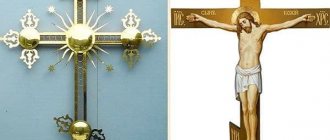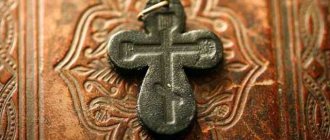The cross is one of the most recognizable symbols in the world. It was once in use among our pagan ancestors and is common in many primitive cultures. But with the advent of Christianity, the cross began to be interpreted precisely as a symbol of belonging to the corresponding religious denomination.
We all know that Orthodox and Catholics wear a pectoral cross in recognition of the selfless feat of Christ, who accepted martyrdom and atoned for all the sins of Humanity. However, not all Christians consider crucifixes to be something sacred and worship the life-giving cross. Many Christians do not recognize any symbols, and their general principles of religion differ from those familiar to parishioners of the Russian Orthodox Church.
Symbolism of the Christian cross
To understand why wear a cross, you need to understand the meaning of the main Christian symbol - the cross. Orthodoxy teaches that 2 thousand years ago the incarnate God Jesus Christ was crucified on a cross-shaped pillar. This was a common type of execution in the Roman Empire. By His voluntary Sacrifice and subsequent Resurrection, the Lord freed humanity from the captivity of sin and spiritual death. The Creator returned to us the opportunity to inherit the Kingdom of Heaven, lost after the fall of Adam and Eve. Venerable Macarius the Great teaches:
“[Christ] came and took away the sin of the world... made a great and saving atonement and healing of the [human] soul. He freed her from slavery and brought her out of darkness, glorifying her with His own light.”
Orthodox pectoral cross
The cross is revered by Christians as a sacred symbol of the redemptive voluntary death of the Savior. As evidence of His immeasurable love and mercy for a lost person. The Holy Fathers call the cross a hard-won trophy of victory over evil and death. This is a sign of Truth and future immortality, the key to the gates of God's Kingdom. Through veneration of the cross we worship the Lord Himself. Let us quote the words of St. John Chrysostom:
“Previously, the cross served as a name for punishment, but now it has become an object of veneration. Previously it was a symbol of condemnation, but now it is a sign of salvation... He freed us from error, enlightened those sitting in darkness... reconciled us with God.”
Christians cross themselves with a cross in prayer, place it on the domes of churches, and wear a cross around their neck. Any reverent inscription of this symbol carries holiness and drives away dark spirits. Saint Demetrius of Rostov notes:
“Displaying miraculous power, any Cross does not act by itself, but by the power of Christ crucified on it and by invoking His Most Holy Name.”
Do Protestants wear crosses?
As mentioned above, Protestantism is very diverse and widespread - the number of different movements within it is measured in the thousands. Most of them are based on unconditional adherence to the Bible, living faith and the priesthood of all believers.
There are practically no canonized saints in Protestantism. More precisely, their lives are not denied, but they are revered, rather, as wise teachers. In most directions, the ritual part is greatly curtailed and is reduced to only two sacraments: baptism (which is usually carried out at a conscious age) and communion. Some currents manage without them at all.
Indeed, Protestants do not wear a cross (at least, representatives of most major movements). The cross is not used in worship and is not an object of worship.
Protestants explain this by saying that true faith does not need material symbols, and their worship is idolatry, which is condemned in every possible way in Christianity. However, they do not reject the symbol of the cross (it decorates houses of worship and is depicted on Bibles that are distributed free of charge), but simply do not worship it.
Protestant houses of worship are usually furnished very succinctly. They lack icons, statues and luxurious utensils. Some movements do not at all recognize the need to have special places for worship: where believers gather, there is a church.
Some branches deny any role of the cross in Christian doctrine. Allegedly, Christ died on a stake, not on a cross. These discrepancies are caused by the nuances of the translation of the Holy Scriptures.
Why wear a cross
A personal cross is given to an Orthodox Christian in the Sacrament of Baptism. It is in this sacred rite that a person gets rid of the power of sin and becomes a Christian, a member of the Church. Saint Gregory the Theologian teaches:
“The grace and power of Baptism cleanses sin in every person and completely washes away all uncleanness and defilement brought by corruption [original sin].”
The connection between the cross and Baptism does not lie in the consonance of these words. In the literal sense, this Sacrament is not connected with the main symbol of Christianity. Their connection is spiritual and semantic.
Is it necessary for baptized people to wear a cross around their neck? It is given for constant wear, since it serves as evidence of the faith of the person being baptized and his devotion to the Lord. This is a sacred reminder of Christ's Redemptive Sacrifice. Without Her, the spiritual cleansing that Gregory the Theologian speaks of would not have been possible.
The cross is also our personal weapon against evil forces. Demons are conscious apostates and enemies of God. Therefore, they cannot bear the grace of the symbol of the commonwealth of man and the Creator. Archpriest Igor Fomin notes:
“The meaning of wearing a cross is multifaceted. This is also evidence of our faith. And the protection of our lives with the instrument of Salvation. And a reminder that the Lord loves us so much that He gave His only begotten Son, so that He, having endured the suffering of the Cross, would give us the opportunity to enter the Kingdom of Heaven.”
Priests warn against blasphemous attitude towards the pectoral cross. This is a shrine, not a fashion accessory. And not a magical amulet designed to automatically help everyone who puts it on. The cross will not serve for the benefit of a person who does not have genuine faith, repentance and the desire to live according to the Gospel commandments.
Orthodox Life
Should an Orthodox Christian always wear a pectoral cross, explains Priest Andrei Chizhenko.
Last Sunday, the following beautiful gospel words were read in churches: “And as Moses lifted up the serpent in the wilderness, so must the Son of Man be lifted up, so that everyone who believes in Him should not perish, but have eternal life” (John 3:14). That is, the Savior directly compared his crucifixion, the erection of the Cross, with the copper serpent, raised thousands of years ago by the holy prophet Moses on a tree in the middle of the desert so that Jews bitten by snakes would look at this copper serpent and be healed. “And the Lord said to Moses: Make yourself a [brass] serpent and display it on a banner, and [if the serpent bites any person] the one who is bitten will look at it and live” (Num. 21:8). In the above-mentioned verse of the Holy Gospel, our Lord and God and Savior Jesus Christ directly compares himself to the copper serpent, and the banner about which God spoke to the holy prophet Moses with the Crucifixion - the Tree of the Cross.
In fact, twice in Holy Scripture God almost directly says that the cross is the main weapon against the enemy and the main means of salvation for fallen man. “Looking at him” - that is, not just a physical action, but most importantly - an impulse of the soul, love for God, for His suffering, for the Crucifixion, the prayer of faith, making the sign of the cross, wearing a cross on the body is a saving act that delivers from the devil, and from troubles, and from various troubles.
After all, in essence, wearing a cross on the body is a bodily physical prayer - a confession of faith, a kind of silent Symbol of Faith. In addition, the Lord directly says that the feat of Christ on the Cross was saving for humanity, which means that the holy cross has a special power of grace. Righteous John of Kronstadt wrote that the cross “is always a great power for believers, delivering from all evils, especially from the villainy of hated enemies.”
In turn, Saint Ignatius (Brianchaninov) in his work “The Word on Death” wrote that around us there is an invisible world of spirits - good Angels and evil demons. Because of our inertia and gross physicality, we do not see it, but thousands, if not millions of ethereal creatures swarm around us. And in this spiritual world there is a constant struggle for the human soul. The Holy Angels wish her salvation, the demons push her to destruction.
The cross, according to the commandment of God Himself and the testimony of the saints, is the most effective weapon against ethereal enemies. Therefore, not wearing a pectoral cross by an Orthodox Christian, in my opinion, can be compared to what would happen if a beekeeper suddenly approached a bee hive without the appropriate protective suit, or if a tiger trainer entered a cage with predators without a whip and a revolver. A person who does not wear a pectoral cross dooms himself to defeat in the battle with demons and may well become their victim.
The remarkable preacher of the early twentieth century, Hieromartyr Gregory, Bishop of Shlisselburg, said in his essay “What you need to know about the devil”: “The second greatest mistake is made when the thought of the devil and the need to fight him disappears from the life of a Christian. Then the person himself gives himself to the elements of evil, giving freely and voluntarily. The following happens: a person thinks that everything around is calm, there is no enemy, and he is careless, lives without looking back, the forces of the soul are asleep, all mental movements are accepted as their own, as natural. This state of human carelessness is what the power of evil takes advantage of, because there are no obstacles for it. Souls are calm, souls are carefree, souls are open... Take a person with your bare hands without resistance. Tragic picture! The man convinced himself that there was no enemy - everything was happening according to natural laws. But the enemy laughs... He comes freely when everything is open and rules. One French writer (Huysmans) said amazing words: “The greatest victory of the devil was to convince people that he does not exist.” Do you hear? Yes, this is Satan's greatest victory. He suggested this. What devil?! Yes, he never existed, and no! This is an old stupid prejudice! And the devil stepped aside. And now he laughs evilly. He is gone, there is no enemy... Down with attention, caution! He will be in charge. Everything is open before him, come into the person and do with him what you want. What happened was as if thieves and bandits assured people that they were not there, that there was no theft. People would open their doors wide and indulge in carelessness. Oh, how thefts and crimes would flourish then! Yes, in material matters, people cleverly lock themselves with ten locks, protect the good, but they don’t think of preserving the good of the soul. The soul is a passageway. Everything is wide open. You are afraid of thieves, but you are not afraid of a spiritual bandit!”
And he also wrote: “The Holy Church believes that at the head of this world (meaning hell. - Author's note) are its ancestors, the first spirits of evil who fell away from God, permeated with lies, welded together by malice, wise by thousands of years of experience. Their task is to fight the Light. Their leadership of the entire world of evil spirits tends to wage the final struggle with the kingdom of Truth, that is, the kingdom of Christ. Hence, the whole life of the world is a struggle with good, the propagation of evil or sin, because evil and sin are identical concepts. And the world of good is saturated with invisible spirits of evil, whose entire existence pursues one goal: to extinguish the Light, destroy good, plant hell everywhere, so that there is a triumph of darkness and hell everywhere. Here are the most basic concepts about the kingdom of evil and its inhabitants. This is a completely real kingdom!”
From my priestly experience, I will say that I personally encountered the fact that demons tried to convince a dying person to take off his cross. And it was truly a difficult and terrible struggle for him.
Therefore, of course, an Orthodox Christian, if possible, should always wear a cross. Especially during communion of the Holy Mysteries of Christ - this real contact with God.
Historical example: our ancestors had special wooden “bath” crosses. If a person’s pectoral cross was made of metal, then in the bath he was given a special wooden cross so that the metal would not burn the skin in the steam room. Our ancestors did not want to remain unprotected from demons anywhere. In our time, when thousands of Christians in Africa and the Middle East die for the confession of the faith of Christ - for the Cross of God, when some of them tattoo the crucifix on their skin so that there would be no temptation to renounce God during torture and death, should we - Orthodox - to take off their crosses in order to become a victim of an evil spirit?
Let us remember, dear brothers and sisters, the sign of the Cross in heaven, revealed to the holy Equal-to-the-Apostles Emperor Constantine, and the voice: “By this, conquer.” The cross is our nickname. The cross is our victory. Let us not deprive ourselves of salvation voluntarily...
Priest Andrey Chizhenko
History of the pectoral cross
In the 4th century in Jerusalem, the miraculous discovery of the Holy Cross by the holy Queen Helen took place. Then widespread veneration of this blessed symbol began, including through wearing it on the body. Later, crosses began to depict the crucified Lord. In the Middle Ages, He was often represented in a different form - blessing or sitting on a throne.
In Rus', the first pectoral crosses appeared in the middle of the 10th century, even before the official adoption of Christianity (988). They were worn by individual Christians who converted to Orthodoxy earlier than other compatriots, “on their own initiative.” After the Baptism of Rus', crosses were worn for some time on top of clothes to publicly declare their faith. Later it became customary to hide the shrine from prying eyes. After all, true faith is manifested not by external attributes, but by life and deeds. Protodeacon Sergius Shalberov, speaking about whether it is necessary to wear a cross, notes:
“Wearing a cross is, first of all, a manifestation of personal piety. But historically it turned out that this custom became familiar and became the norm of Christian life. And the absence of a cross began to be regarded as a sin and a departure from the faith.”
During periods of atheistic persecution, many Christians suffered and became holy martyrs for refusing to take off their cross and renounce Christ. The Slavs had a pious custom of exchanging personal crosses as a sign of brotherly love and fidelity.
Emergency situations
Wearing the cross, which is an eternal reminder of how Christ, by dying on the crucifixion, simultaneously conquered death, is a kind of constant silent prayer.
Thus, by removing it from oneself, a person seems to interrupt his connection with the Almighty, and in order to remain under the protection of God even in extreme situations, Priest Svyatoslav Shevchenko offers the Orthodox to take advantage of some interesting ideas.
For safety reasons, during a surgical operation or examination in a magnetic resonance imaging scanner, no foreign objects should be present on the human body, but Orthodox people can remain at the cross without violating clinical rules. To do this, the patient must draw a small cross on his chest with iodine or brilliant green.
When visiting a fluorography room, you can take a body crucifix into your mouth, while relaxing in the bathhouse you can put on a wooden cross illuminated in the church, and during training and performances in contact sports you can replace it with a knitted belt with the 90th Psalm, on which there is an image of a cross.
By the way, Sergius Shalberov advises that when changing the baptismal cross to alternative options, when the body and soul are left without the protection of the Almighty for a few minutes, continuously read a short prayer to yourself.
Pectoral cross: rules of circulation and common misconceptions
The pectoral cross of an Orthodox Christian must be of a canonical shape (4, 6 or 8 ends) and consecrated. There is no special canonical teaching of the Church on wearing the cross. However, as already mentioned, traditionally the shrine is not worn for show, but under clothing.
The cross can be wooden or metal, on a string or a chain - it doesn’t matter. The main thing is to wear it with faith and reverence. It is not customary to remove the cross in everyday circumstances (when bathing, changing clothes, etc.). This is acceptable in special situations, such as during medical procedures. You don’t have to wear the same cross your whole life; you can change it. It is also not forbidden to give this shrine or receive it as a gift.
Archpriest Nikolai Markovsky warns against superstitions associated with the pectoral cross. For example, some people are convinced that dropping or losing it will bring bad luck. The priest notes:
“People work, rush about business, play sports. It may happen that a person loses his pectoral cross. You can't attach any significance to this. You need to buy another one from the icon shop. Put on a new one and wear it with faith and prayer.”
If the cross on the neck has darkened, it means that the metal has oxidized. One should not look for mysticism in this either. Another example of superstition: supposedly you cannot pick up, much less carry, a cross that someone has lost. It is believed that this will change fate and “hang” other people’s sins on a person. Father Nikolai reminds us that in Christianity there are no concepts of predestination and fate. Man has free will and builds his own life. The priest calls not to allow the shrine to be trampled underfoot. The found cross should be picked up and taken to the temple.
The power of the cross
The martyr Peter of Damascus wrote about the saving and protective power of the pectoral cross: “By the inscription of the Honest and Life-Giving Cross, demons and various diseases are driven away; and this is done without any expense and without labor. And who can count the praises of the Holy Cross?
Saint John of Kronstadt reflected in the same context, saying that for believers, the pectoral cross “is a great power that delivers from all evils, especially from the villainy of hated enemies.”
The elder of the Pskov-Pechersk Monastery Savva (Ostapenko) called for respectful treatment of the body crucifix, without which any Christian seems to be a defenseless warrior without weapons. Warning the laity against using the pectoral cross as decoration, he advised kissing his crucifix every day in order to inhale the “rays of blessed light and love” emanating from it, imperceptibly penetrating the soul, conscience, character and heart of a person.
However, Sergius Shalberov warns that the pectoral cross should not be considered a kind of protective amulet that helps everyone who wears it day and night. If an individual doubts God, does not have church consciousness, leads an immoral lifestyle and does not keep the Gospel commandments, then he will not gain any benefit from wearing a cross. And on the contrary, if a truly Orthodox person, for good reason, is forced to remove his body symbol of faith for some time, this fact will not in the least diminish his righteousness, and certainly will not be sinful.
Prayer to the Holy and Life-Giving Cross of the Lord
A short prayer to the Cross
Protect me, Lord, by the power of Your Honest and Life-giving Cross, and save me from all evil.
Prayer
May God rise again, and may His enemies be scattered, and may those who hate Him flee from His presence. Like smoke disappears, let them disappear; As wax melts in the presence of fire, so let demons perish on behalf of those who love God and sign the sign of the cross, and say in joy: Rejoice, Most Honest and Life-Giving Cross of the Lord, driving away and the demons have the power upon you of our Lord Jesus Christ, who descended into hell and trampled underfoot the power the devil, and who gave us Your Honest Cross to drive away every adversary. Oh, Most Honest and Life-Giving Cross of the Lord! Help me with the Holy Virgin Mary and with all the saints forever. Amen.
Translation: May God rise again, and may His enemies be scattered, and may all who hate Him flee from Him. As smoke disappears, so let them disappear; and as wax melts from the fire, so let the demons perish before those who love God and are marked by the sign of the cross and exclaim in joy: Rejoice, Most Honored and Life-Giving Cross of the Lord, driving away demons by the power of our crucified Lord Jesus Christ on you, Who descended into hell and destroyed the power of the devil and gave us You, Your Honest Cross, to drive away every enemy. Oh, Most Revered and Life-Giving Cross of the Lord, help me with the Holy Lady the Virgin Mary and with all the saints in all ages. Amen.
Read us conveniently on social networks:
Tags: why wear a cross, cross on the neck, cross on the neck, is it necessary to wear a cross, is it necessary for baptized people to wear a cross on their neck
Why don't Baptists wear a cross?
Baptist doctrine is one of the widespread branches of Protestantism. In Russia it is perhaps the most popular. Baptists place great importance on everything written in the Bible, are baptized at adulthood, and do not tolerate idolatry in any form. This is what they consider to be the worship of the cross: from making the sign of the cross to wearing a cross on the body.
Baptists do not wear a cross, first of all, because the Bible nowhere says that believers should worship it. Moreover: they consider the veneration of the cross to be something blasphemous, because Jesus Christ died on it. Is it possible to worship an instrument of execution?
Gold pendant with cubic zirconia (go to the SUNLIGHT catalogue)
However, the most advanced representatives of this denomination believe that the cross must be treated with respect. However, one should not confuse respect with admiration and replace true faith with material symbols.
Baptists are naturally opposed by representatives of the Orthodox clergy, citing the words of the Apostle Paul from the Bible. The saint greatly revered the life-giving cross and called all believers to this.
The cross is not so much an instrument of execution as a symbol of the resurrection of Christ, whose martyrdom gave Humanity a chance for salvation. At least, according to the majority of Orthodox Christians.










